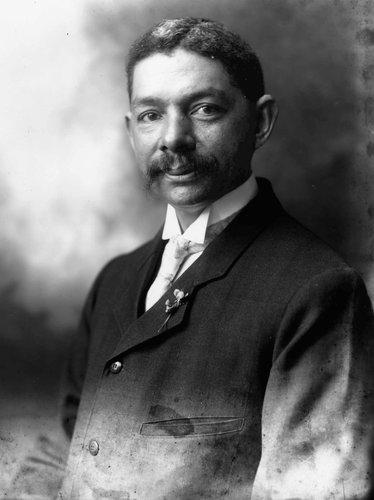Robert Robinson Taylor (1868 – 1942) was the first academically trained and credentialed Black architect in America. He was born on June 8th, 1868, in Wilmington, North Carolina. His family’s background was more privileged than most at the time, as his father, Henry Taylor, the son of a white slave owner, was given the freedom to go into business for himself as a carpenter prior to the Civil War. He prospered in his career as a builder, constructing cargo ships and large commercial buildings. With his background, Henry Taylor wanted his son Robert to have formal technical training, which led him to his educational career at MIT.
During his years at MIT (1888-1892), he excelled above the class average, earning honors in architectural history, trigonometry, and applied mechanics, amongst many other courses. With his drive to make an impact, he wrote his thesis, “Design for a Soldiers’ Home,” in which he wrote about the importance of creating a facility for veterans with long-term care needs.
“In a building of this kind, the designer should keep several things prominently in his mind. He should have the different parts of his building well connected in order to allow free circulation; still, he ought not connect too intimately the hospital with parts of the building designed for other uses. Then, as the inmates of the home are infirm, he should use the greatest allowable area and as few stories as possible in order to avoid climbing several flights of stairs. For whatever purpose intended, he should have his rooms large, well lighted, and well ventilated.”
View his architectural drawings here
While studying at MIT, Taylor made a deep connection with Booker T. Washington, a prominent Black educator and race leader from Tuskegee, Alabama. Washington founded the Tuskegee Institute, a highly acclaimed African American school that focused on manual training, industrial education, and crafts to prepare its students for careers. In 1892, soon after Taylor’s graduation, Washington sought Taylor to develop an industrial program at Tuskegee and direct the construction of new campus buildings after hearing of his high performance at MIT. Taylor was an ideal recruit for the position, not just for his highly acclaimed educational background, but because he had a great interest in combining his knowledge of architecture with a career in the education field.
His first project on Tuskegee’s campus was the Science Hall, later renamed Thrasher Hall, which was constructed entirely by students under Taylor’s direction. The Hall held classrooms and laboratories. He then went on to construct numerous other buildings on campus including The Chapel (1895-1898) and The Oaks, which served as Tuskegee’s presidential residence. The Chapel featured a 105-foot tower, seating for approximately 2,400, and high-arched hammer-beam trusses. Booker T. Washington referred to the site as “the most imposing building at Tuskegee.” It was the first electrified building in Macon County, Alabama and the lights were installed by students at the Institute.
Taylor went on to become Director of Mechanical Industries at Tuskegee where he and Booker T. Washington worked together to develop an even stronger program to highlight the skills of the students there. During his career, he also designed buildings at several other colleges, such as Wiley College in Marshall Texas, and Livingstone College in Salisbury, North Carolina. As an instructor in architectural and mechanical drawing, Taylor discovered that “the mechanical work was largely in the hands of men trained in the old way, who did their work usually without definite plans or drawings. Introducing plans, blueprints, and specifications as a part of every mechanical job, however small, and instructing the students in making and using drawings, led to changes which inevitably follow newer and better ways of doing things,” (Robert R. Taylor, The Scientific Development of the Negro, 1911).
During the 1920s, Olivia Phelps-Stokes, an American Philanthropist, expressed her interest in financing a similar type of institute in Africa to Booker T. Washington. Soon after, the Tuskegee Institute received a visit from Liberian President, Charles D. B. King. After touring the campus and returning to Liberia, King hired Taylor to design a campus for a similar school in Kakata. “The Liberian government donated 1,000 acres for the proposed Booker Washington Agricultural & Industrial Institute (BWI). This “Tuskegee of Africa” was under the joint sponsorship of the Phelps-Stokes Fund, the Liberian government, and the Firestone Rubber Corporation (which had opened the world’s largest rubber plantation in Liberia in 1926). Other supporters included the American Colonization Society, missionary boards, and individuals,” (MIT Black History, 2024). Several years later, Taylor traveled to Liberia to lay out architectural plans and develop a program for the school’s students. With his direction, the school was Liberia’s first agricultural and vocational school, as well as the largest secondary school in the country at the time. As of 2014, the school has been transitioned to a community college. Taylor’s great success on this project earned him an honorary doctorate from Lincoln University in Pennsylvania and solidified him as a renowned individual in his field.
He retired from the Institute in the mid-1930s. Following his retirement, the governor of North Carolina appointed Taylor to the board of trustees in 1935 of what is now Fayetteville State University. He also served as chairman of the Tuskegee chapter of the American Red Cross. He devoted much of his time to civic work and writing social justice pieces for various newspapers.
Robert Robinson Taylor died on December 13th, 1942, after a sudden health emergency in the Tuskegee Chapel, the very chapel he designed and constructed and that was considered his most outstanding achievement as an architect. His legacy lived on as he was regarded as a hardworking and devoted advocate of both architecture and education. The Taylor School of Architecture and Construction Science was named after him at what is now Tuskegee University, and he was recognized in the designation of the Tuskegee campus as a National Historic Site. In 1994, MIT endowed a chair for minority faculty in Taylor’s name. It is the first chair at the Institute named in honor of an African American. In addition, the United States Postal Service commemorated Taylor by creating a limited-edition Forever U.S. Postal Stamp in his image. The stamp was introduced at the Smithsonian National Postal Museum on February 12th, 2015, and was the 38th addition to the postal service’s Black Heritage Series.
Sources:
Robert R. Taylor. MIT Black History. (n.d.). https://www.blackhistory.mit.edu/story/robert-r-taylor
Tuskegee University. (n.d.-b). https://www.tuskegee.edu/about-us/history-and-mission






